Party: Work
The Hunt family started crafting wine in 1981 and has been farming west of Keuka Lake in New York’s Finger Lakes region for seven generations. Hunt Country Vineyards is committed to responsible farming and caring for the land that gives us so much. They have reduced fossil fuel use by installing award-winning solar and geothermal systems. A portion of the vineyards are certified organic and several wines are made from organic grapes. Hunt Country Vineyard received the 2020 Sustainability Award from the New York Wine & Grape Foundation for its sustainability practices.
Growing up on the farm and with the winery inspired Suzanne Hunt’s passion for sustainability, climate solutions, and clean energy. She’s spearheaded a multitude of sustainability and climate resilience efforts. In 2021 Suzanne and her parents were recognized by Wine Business Monthly as some of the top leaders who shape the way the wine industry operates. In this interview, Suzanne shares ways others in the industry can work on being more sustainable.
Has Hunt Country Vineyards always been environmentally focused?
Suzanne Hunt: Yes, my parents bought the family farm from the previous generation in the 1970s because they wanted to live on the land. Environmental concerns have shifted somewhat over time. Decades ago, the key concerns for ecologically-minded farmers were things like DDT, erosion, and fertilizer leaching into water supplies. Nowadays the most pressing concerns include climate change, ‘forever chemicals’, invasive species, and loss of pollinators. Soil conservation has shifted to more complex considerations of soil health and soil as a tool in carbon sequestration and storage. Wildlife stewardship, erosion, and water quality concerns have been fairly consistent.
“The nuts-and-bolts of sustainable vineyard practices are waste reduction, energy and water conservation, and other essentials. But I would stress advocacy and customer education as well.”
Which processes were easier to implement?
SH: Well, every change requires effort. But some of the things we’ve done that are relatively straightforward and not difficult include: using only compost and manure as fertilizer instead of synthetic fertilizers, switching to efficient LED lighting, using eco-flooring and other eco-building materials, using lightweight/eco glass bottles, recycling, installing bird and bat boxes, and planting pollinator habitat.
What were some of the more challenging processes you experienced making the shift to a more environmentally focused vineyard?
SH: We have struggled with weed control in our certified organic vineyards. With a permanent crop like vines, we don’t have as many tools in our toolkit as our organic farmer friends who grow annual crops and can rotate crops and so on.
We were the first large complex geothermal system that the local companies had installed over a decade ago when we invested in a geothermal system to heat and cool all of our large buildings. The installers were learning as they went so we’ve had a lot more challenges with our geothermal system than folks will have now that there are more experienced installers, and better quality equipment that comes with diagnostic tools to target maintenance.
When we installed 348 solar panels on our building roofs in 2015, it took quite a lot of time and effort. Our local banks had never financed large commercial solar power systems so we arranged for the President of the NY Green Bank and some of his staff to spend an afternoon fielding their questions related to warranties, equipment depreciation, etc. Getting the permits was also much more of a struggle than it should have been.
We’ve had a harder time because we’ve been making these changes before they were common practice. It will be easier for other businesses that make the investments now.
What do you think are some of the most important practices of an environmentally focused winery?
SH: There are the nuts-and-bolts sustainable vineyard practices, waste reduction, energy and water conservation, and other essentials. But I would stress advocacy and customer education as well. The environmental challenges we face require direct action. Changing practices on our farms and in our businesses as well as society-wide approaches. Many of these environmental challenges are system-wide and societal challenges that require policy, regulatory, and systems changes.
As a highly visible industry, our voices as business leaders carry weight. We need to use them. And, we are also a rare part of farming where the public actually comes to spend time at our farms, which is an opportunity to help raise awareness and activate our customers.
Back to the nuts and bolts: farming involves challenging physical and economic conditions that are constantly changing – so it’s important to focus on constant improvement as our scientific knowledge expands and the tools available to us evolve. It is also critical to focus on practices that will enhance the resilience of your operation as well as provide environmental benefits. A good example of a practice that achieves multiple goals, including enhancing resilience to extreme dry and extreme wet conditions (which will worsen as climate change intensifies), is enhancing soil organic matter.
The new New York State Sustainable Winegrowing certification program is a good place to start. Growers and wineries can go through hundreds of aspects of their business and identify areas for improvements related to environmental impacts but also safety and other social and economic sustainability metrics.
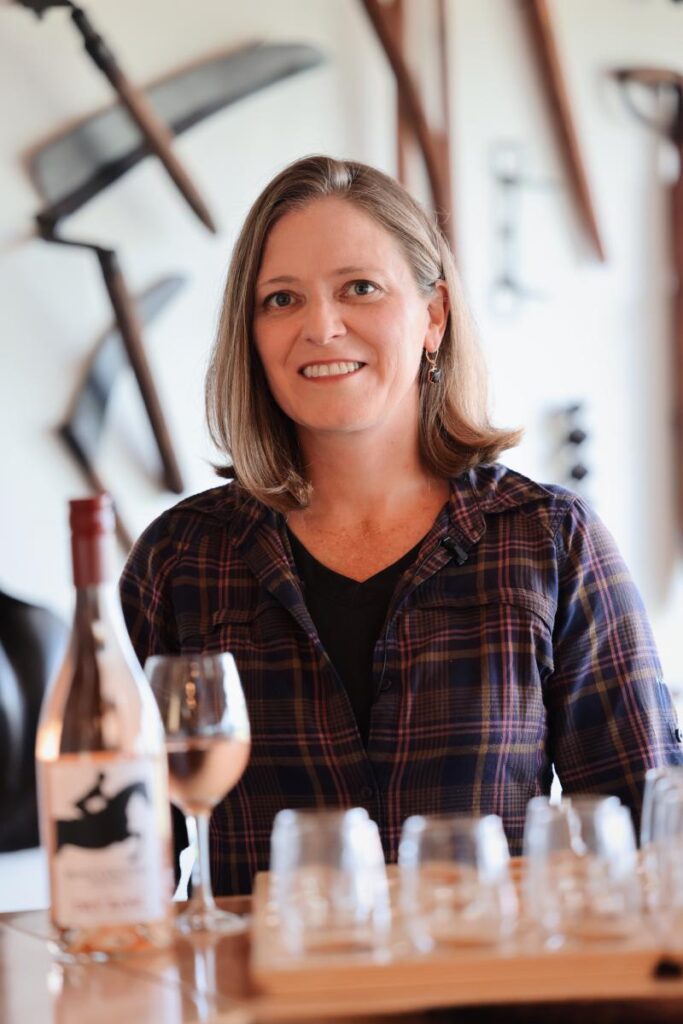
What other local (or national) wineries are doing the work?
SH: We are the first New York winery to join the International Wineries for Climate Action (IWCA) organization that was co-founded by two large international wineries: Torres Family Winery (from Spain) and Jackson Family Winery (headquartered in California). But the IWCA has members of all sizes including Cakebread Cellars, Opus One, and other well-known brands. To become a member you have to go through a rigorous greenhouse gas accounting process and third-party audit.
About a dozen New York winery owners serve on the New York Wine and Grape Foundation’s Sustainability Advisory Committee which I chaired until recently. We have spent the past several years developing and testing out a sustainability certification program designed for New York grape and wine producers. Currently, we, and several dozen other Finger Lakes producers, are in the process of getting certified. Soon New York wine drinkers will start seeing the New York Sustainable Winegrowing ‘Trustmark’ on our websites, social media posts, and eventually bottle labels.
What do people need to look out for to confirm if a winery has sustainable practices?
SH: Consumers can look for trust marks but until now we didn’t have a comprehensive sustainability certification that was relevant to New York wine growers. So the most important thing consumers can do is ask questions and get to know the wineries that they frequent. Read articles like this and educate yourself on who the leaders are and support them!
“Every generation that came before us had to innovate to succeed in farming and business. We are no different, but the pace of change is accelerating, making innovation even more critical to our ability to succeed.”
What inspired your passion for climate solutions and clean energy?
SH: This place. Growing up on the farm and with the winery. It was really hard-going for my parents when I was a kid. They, and their contemporaries, were building a New York wine industry almost from the ground up after the grape market crashed. They made sure my siblings and I could follow our passions and mine was always the environment.
I was able to get degrees in Environmental Science, Natural Resources Management, and International Affairs and work in the environmental field all over the world before returning home. I still work in sustainable infrastructure, agriculture, and transportation-related policy. Although you could argue that having two full-time jobs is not sustainable!
Why is innovation so important?
SH: Farming has always been hard. Nowadays the impacts of climate change, labor shortages, economic crises, and other disruptions are making it even harder. Every generation that came before us had to innovate to succeed in farming and business. We are no different, but the pace of change is accelerating, making innovation even more critical to our ability to succeed.
What are some ways Hunt Country Vineyards has had to innovate?
SH: So many ways! The winery was an innovation in response to the grape market crash. In the 1970’s after the grape market crashed my parents learned how to make wine out of the hundreds of tons of grapes they couldn’t sell. Not all of the varieties that they were growing were desirable for winemaking, but the vineyards were the collateral on the loans they took out to plant the vines so they couldn’t rip them out. So my dad worked with Cornell and pioneered cold climate field grafting and grafted new varieties onto some of the existing vineyards.
In the 1980’s our ice wine bottles were too small for our labeling machine so my dad attached an electric motor to a manual labeler from 1910. There are countless examples like that. My mom helped start up several Finger Lakes wine promotion organizations and programs.
Most recently, the release of our Uncharted Terroir (UT) line of wines is an innovation in response to the unpredictable impacts of climate change. Our UT wines are made from hybrid grape varieties that have typically been looked down on in the wine world. But when you give these grapes the same love and attention as their vinifera cousins, you can make outstanding wines.
Hybrid grapes are far more resilient and rugged than vinifera grapes, so they can withstand and bounce back from the increasingly frequent extreme weather events we are facing. For example, the surprise frost in May 2023 that hammered vineyards in New York devastated our Cabernet Franc, Chardonnay, and Riesling. But our Vidal Blanc and Vignoles look like they’ll still give us a significant crop.
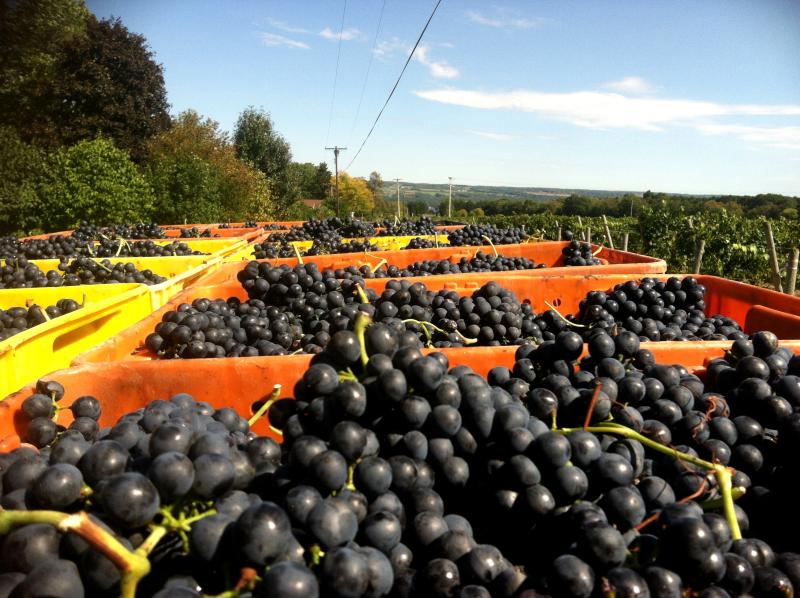
What advice can you offer smaller wineries that don’t have huge budgets to invest in large sustainability-focused infrastructures/processes, but want to be more environmentally conscious?
SH: Work with your local soil and water department. They can often help with technical assistance and potentially partner on grants to help test out or implement new practices. Right now we are working with our local soil and water department on a project to study the effects of adding compost and biochar to our vineyards and hay fields funded in part by a climate-smart agriculture grant. We are also working with them, along with some of our neighbors, to test out an under-the-row mower.
Develop a strong relationship with a local bank so that you can use loans to pay for some of the investments with shorter payback periods. Develop partnerships. For example, we partnered with Tesla to install five electric vehicle charging stations in our parking lot.
In what ways are you looking to expand in the future?
SH: We’re always looking for new ways – big and small – to improve. My dad is always tweaking, and even inventing new machines and strategies to try to improve practices in the vineyards. We’ve worked closely with researchers at Cornell over the decades on improved management strategies and will continue that collaboration.
From a climate impact perspective, packaging is one of the biggest sources of greenhouse gas emissions from the wine industry. Glass manufacturing requires an enormous amount of heat, and in the U.S. right now that heat is supplied primarily by fossil fuels. I’m in the very early stages of working with large wineries to try to create enough demand to get our glass suppliers to work with the government and renewable fuel suppliers to slash their emissions. We’re also always working on phasing in electric vehicles.
In collaboration with scientists at the US Department of Agriculture, we are going to plant a 5-acre field next to the forest on our farm with wildflowers to support native pollinator populations – many of which are ground-dwelling and benefit from proximity to forest habitat. We’ll manage the field to keep in wildflowers into the future.
From a broader ‘what people need right now’ perspective, we are focusing on getting people here for hands-on (phones off) workshops and retreats focused on skills development, enhancing well-being, community building, and problem-solving.
Our advocacy is focused on the implementation of the New York climate law and on the conservation title of the federal Farm Bill which is only renewed once every five years.
In addition to being a co-owner of her family’s seventh-generation farm and winery, Suzanne Hunt is the Vice President for Public Policy for Generate Upcycle, PBC which finances, builds, owns, and operates sustainable infrastructure projects in North America and Europe.
The climate of Finger Lakes Wine Country is ideal for growing grapes due to a combination of factors related to temperature, humidity, soil, and the unique geography of the region. Here’s why the Finger Lakes region, including areas like Seneca Lake, provides an excellent environment for viticulture:
1. Moderating Effect of the Lakes
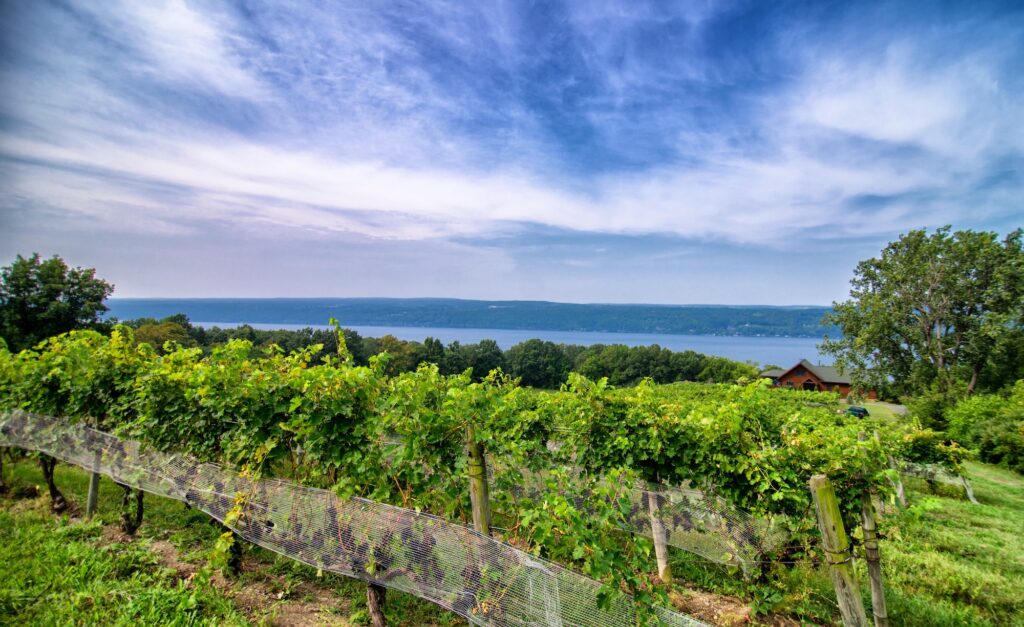
The Finger Lakes are a series of long, deep, glacial lakes, and their large bodies of water play a crucial role in regulating the climate in the surrounding areas. During the growing season, the lakes act as a thermal buffer, absorbing heat during the warmer months and releasing it slowly in the cooler months. This moderates temperature extremes, protecting vines from late spring frosts and early autumn freezes. The relatively longer growing season this creates allows grapes to ripen fully, while also helping to preserve their acidity, which is crucial for producing high-quality wine.
Summer: The lakes help maintain a moderate daytime temperature. While the surrounding regions may experience hot spells, the lakes’ waters help keep the air cool, preventing the grapes from overheating.
Fall: As temperatures begin to cool in the autumn, the lakes continue to release heat, providing a more gradual transition to cooler weather. This extended growing season is essential for grape ripening, especially for varieties like Riesling, which thrive with a long, cool growing season.
2. Cool Climate Viticulture
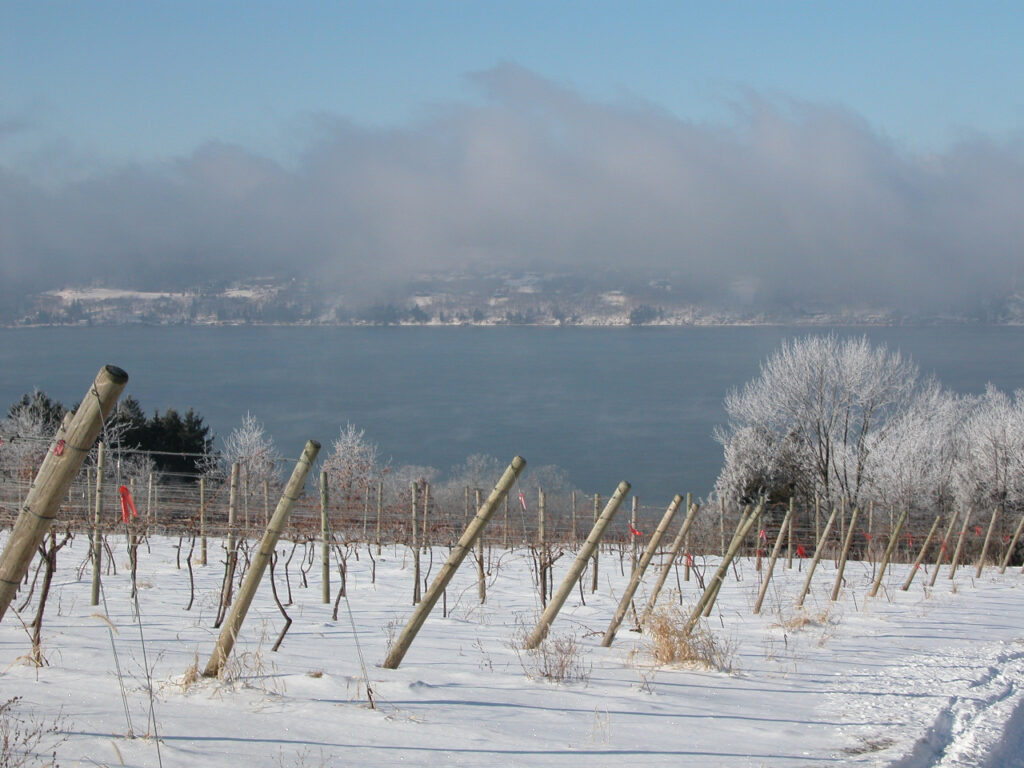
The Finger Lakes region is considered a cool-climate wine region, which is perfect for certain grape varieties that prefer cooler growing conditions, such as Riesling, Chardonnay, and Pinot Noir. The cooler climate helps grapes maintain their acidity, which contributes to the crispness, balance, and freshness of Finger Lakes wines.
Cooler temperatures also help prevent over-ripening of the grapes, which can lead to a loss of delicate flavors and aromatics. This is particularly important for white wine grapes, which require cool weather to maintain their signature bright, fresh profiles.
3. Soil Composition

The Finger Lakes region benefits from well-drained, nutrient-rich soils, especially around the lakes. The soil is often a mixture of loam, clay, and gravel, which provides excellent drainage while holding just enough moisture for grapevines. These well-draining soils help prevent root diseases and ensure that the vines are not waterlogged, which could otherwise negatively affect grape development.
In addition, the glacial deposits in the region have left a rich mixture of minerals, which contributes to the terroir of the wines. The mineral content in the soil helps give Finger Lakes wines their unique, often mineral-driven characteristics.
4. Topography
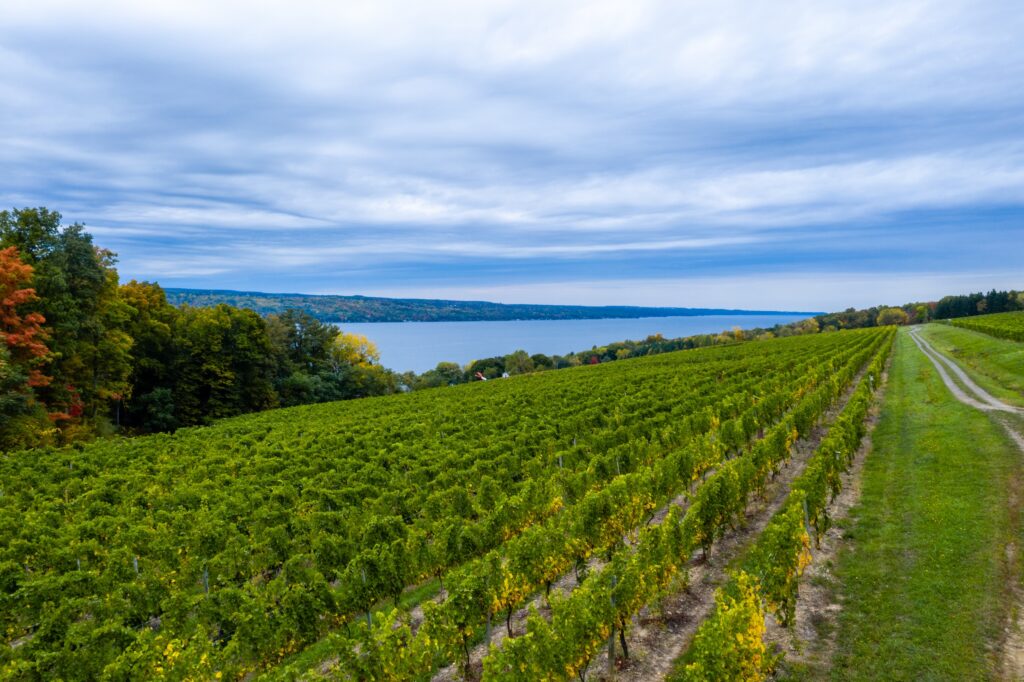
The region’s hilly, sloping terrain is another factor that makes it suitable for grape growing. The hillsides allow for optimal sun exposure, ensuring that grapevines receive plenty of light during the growing season. Vineyards planted on south- or west-facing slopes get more sunlight, which aids in grape ripening and helps concentrate flavors in the fruit.
Additionally, the slopes help with air circulation, reducing the risk of frost in the spring and fall. Cold air tends to settle in valleys, so by planting vineyards on elevated sites, wineries can reduce the chances of frost damage, especially in early spring when frost is most damaging to delicate grape buds.
5. Humidity and Rainfall
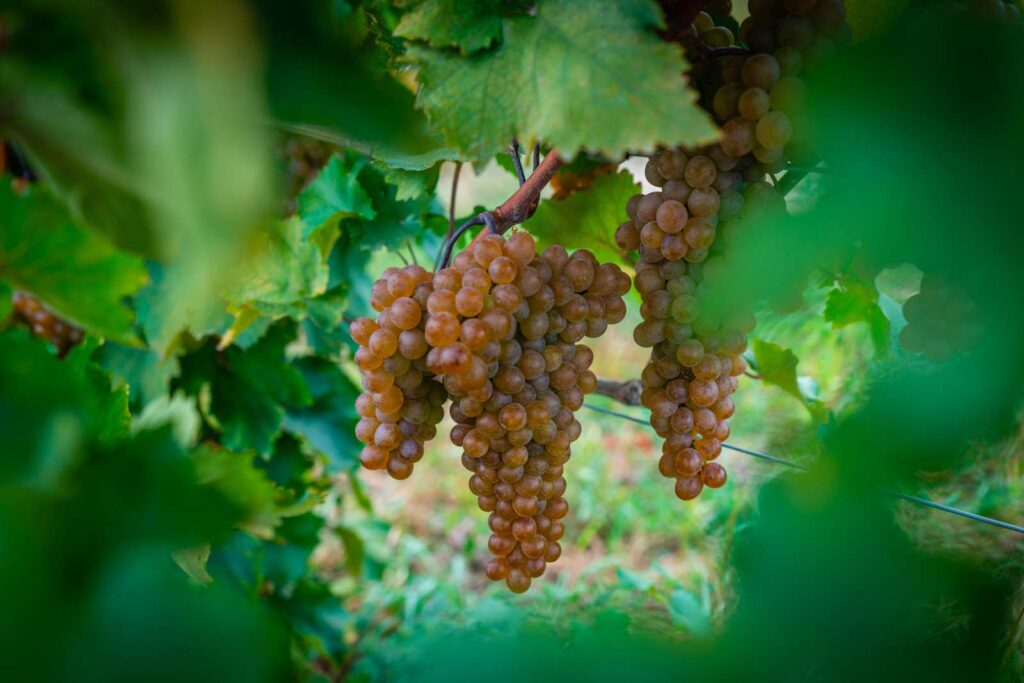
The Finger Lakes region enjoys moderate precipitation, which helps maintain healthy soil moisture for grapevines. The region typically experiences around 30-40 inches of rain per year, which is enough to keep the vines hydrated without causing excessive waterlogging.
In terms of humidity, the lakes themselves contribute to a relatively humid environment. While too much humidity can promote fungal diseases, the region’s cooler temperatures and good airflow (especially around the lakes) help mitigate this risk, ensuring that vines remain healthy.
6. Protection from Harsh Winters
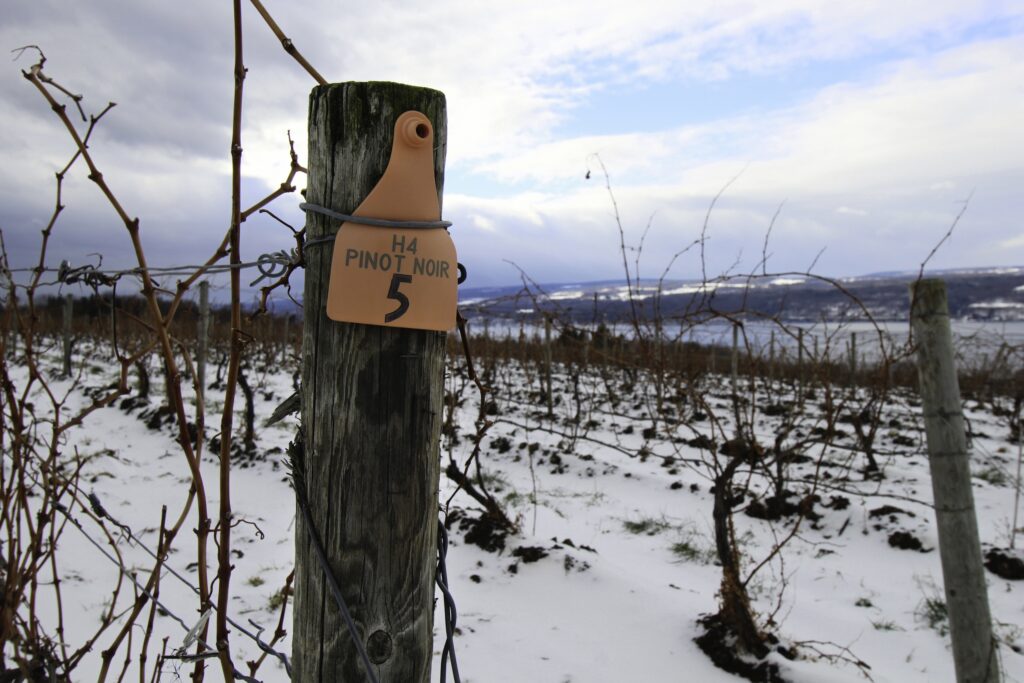
While the Finger Lakes region does experience cold winters, the moderating influence of the lakes helps protect the vines from the extreme winter temperatures experienced in more inland, northern regions. In addition, many vineyards practice winter protection techniques such as burying the vines or using wind machines, helping to further shield the vines from frost damage.
7. Regional Climate Variations
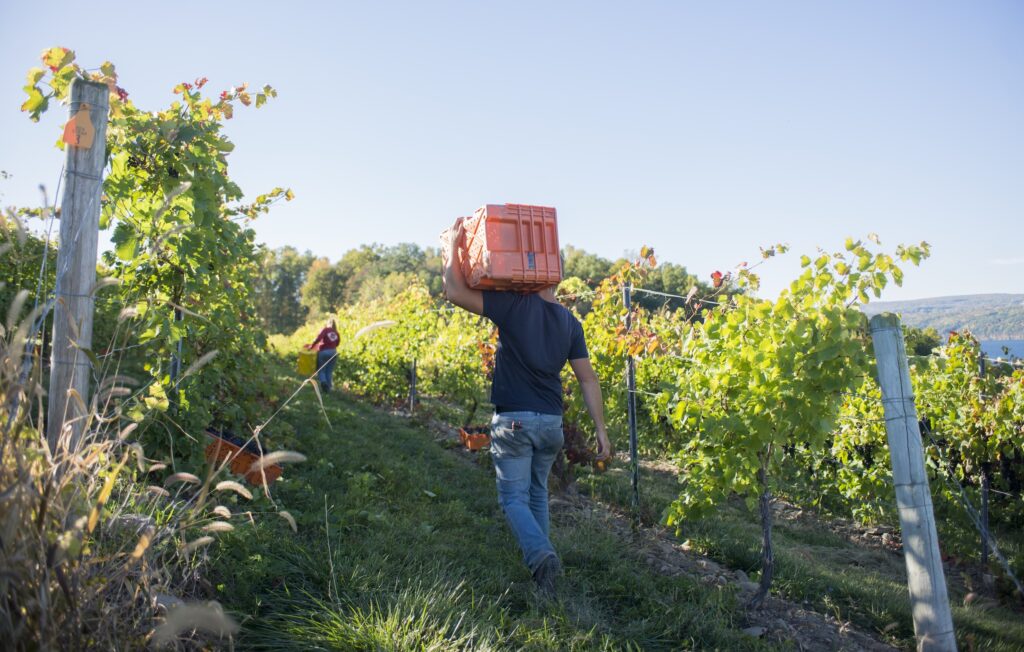
Different Finger Lakes, like Seneca Lake, Keuka Lake, and Cayuga Lake, each have their own microclimates, influenced by their size, depth, and orientation. These microclimates can create subtle variations in temperature and humidity, which allows winemakers to experiment with different grape varieties and styles of wine.
For example, Seneca Lake has the deepest of the Finger Lakes, which means it has a greater capacity to moderate temperatures, creating an even more favorable growing environment for longer-maturing grape varieties like Cabernet Franc or Gewürztraminer.
Overall, the cool, moderate climate, combined with the protective influence of the lakes, well-draining soils, and favorable topography, makes Finger Lakes Wine Country one of the best places in the U.S. for growing high-quality grapes, particularly cool-climate varieties. These conditions allow the region to produce wines with exceptional balance, crisp acidity, and distinct terroir, making it a renowned wine-growing region.
A Year-Round Destination
Finger Lakes Wine Country offers a distinctive climate that changes beautifully through each season, providing unique experiences year-round. Whether you are drawn to the bud break of spring, serene lakes and rivers in summer, the snowy charm of winter, or the vibrant foliage of autumn, you’ll find plenty to explore in this breathtaking corner of New York. Here’s what to expect from the weather and how to dress during each season.
Spring
(April – May)

Spring in the Finger Lakes is a time of renewal, where nature comes alive after the cold winter months. Average daytime temperatures range from 50°F to 70°F, but evenings can be quite chilly, often dipping into the 30s or 40s. It’s a time when the grapevines begin to bud, and the local flora—tulips, daffodils, and lilacs—brighten the landscape with color.
What to Wear: Light layers are key. A light sweater or long-sleeved shirt under a jacket will keep you comfortable during the day, but don’t forget a heavier jacket or a warm sweater for the evening chill. Comfortable shoes for walking or exploring wineries are also recommended, as the terrain can be uneven, especially around the lake.
Summer
(June – August)

Summer in the Finger Lakes is a true highlight, with warm, pleasant weather ideal for outdoor activities. Daytime highs typically range from 70°F to 80°F, with occasional hot spells pushing into the 90s. The area enjoys long, sunny days with cool, breezy evenings, especially near the water. The lakes sparkle under the summer sun, and outdoor festivals, boat tours, and wine tastings are in full swing.
What to Wear: During the day, lightweight clothing, such as shorts, breathable shirts, and a hat, is perfect for staying cool. Don’t forget sunglasses and sunscreen, as the sun can be strong, especially during midday. A light jacket or sweater might come in handy for cooler evenings by the lakes and rivers, and comfortable sandals or shoes are ideal for walking around festivals or the small towns, but don’t forget your hiking shoes and swimsuits for outdoor adventures!
Fall
(September – November)

Fall is an incredibly popular time to visit Finger Lakes Wine Country! The weather is crisp and cool, with daytime temperatures ranging from the 50s to the 60s°F, and evenings can drop to the 30s or 40s. The region’s famous fall foliage reaches its peak, painting the hillsides with vibrant reds, oranges, and yellows. The harvest season brings an aroma of freshly picked grapes and the chance to explore apple orchards, pumpkin patches, and U-pick farms.
What to Wear: As temperatures fluctuate, dressing in layers is essential. A warm jacket, a scarf, and a pair of gloves will be useful, especially on chilly mornings or evenings. A sturdy pair of boots is also recommended, as you’ll likely want to explore the vineyards or hike the picturesque trails near the lake. A cozy sweater or fleece can help keep you warm as you enjoy the beautiful outdoor scenery.
Winter
(December – March)

Winter in the Finger Lakes brings a tranquil beauty to Finger Lakes Wine Country, with snow-covered landscapes and a quiet ambiance. Temperatures can vary significantly, ranging from sub-zero conditions to highs near 40°F. The area sees plenty of snowfall, which creates perfect conditions for snowshoeing, cross-country skiing, and other winter activities. While many of the area’s attractions slow down, it’s an ideal time for a peaceful retreat with fewer crowds. You can enjoy cozy firesides at local inns or indulge in winter wine tastings, including the special Ice Wine produced from frozen grapes.
What to Wear: Winter weather can be unpredictable, so make sure to pack heavy-duty cold-weather clothing. A thick, insulated coat, gloves, a scarf, and a warm hat are essential for staying comfortable outside. Thermal layers and waterproof boots will help you stay warm and dry during outdoor activities, especially if you plan to hike or snowshoe around the lake. A pair of wool socks and a cozy sweater will also keep you comfortable when you head indoors to enjoy a glass of wine by the fire.
No matter when you choose to visit Finger Lakes Wine Country, each season offers its own charm and opportunities to experience the region’s natural beauty and unique culture. From spring’s fresh blooms to winter’s snowy peace, the climate in this region makes it a year-round destination for those looking to enjoy outdoor adventures, local products, and breathtaking landscapes. Be sure to pack accordingly and get ready to explore New York’s most stunning region!
During your stay, visit our Tasting Room and Retail Shop up the hill to sample award-winning Finger Lakes wines or take a cellar tour. Afterward, enjoy a delicious meal at Veraisons Restaurant, offering locally sourced regional cuisine, along with a selection of local wines, beers, and spirits. Don’t forget to save room for dessert!
Market Street
Shop, eat, and drink along Market Street in the heart of Corning’s Gaffer District, where you’ll find independently owned local shops, cafés, restaurants, and places to grab your favorite local beverage along this quaint, tree-lined street. Learn more about the Gaffer District’s gorgeous 19th-century buildings through their Buildings Alive self-guided historic architecture tour. For your home away from home, check out the Radisson Hotel Corning, conveniently located at the east end of Market Street, or experience a stay at Hilton Garden Inn Corning, next to the Corning Museum of Glass, and a short walk into the town center.
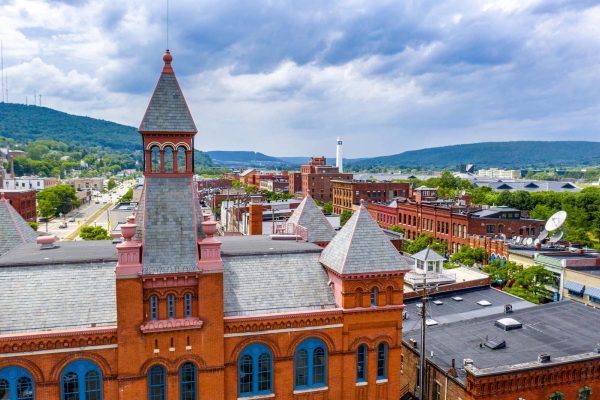
More Than Just Your Grandmother’s Cookware
Corning Incorporated, a Fortune 500 company and one of the world’s leading innovators in materials science, is headquartered in Corning. Corning Incorporated has a 169-year track record of life-changing inventions, including the cookware your mother and grandmother used growing up, CorningWare (1958), and Pyrex (1915). Corning Incorporated develops products that transform industries and enhance people’s lives, many of which we use in everyday life, including our LCD TVs and computer monitors, automobile windshields, and smartphone screens! Explore the local antique shops for vintage Corningware and other favorite Corning glass items!
Corning Museum of Glass
You can find the world’s most comprehensive glass collection, with over 50,000 objects representing more than 3,500 years of history, from the Pharaohs to modern-day contemporary glass. Experience live demonstrations, research archives, unique retail, and glass at the immersive and interactive Corning Museum of Glass. Explore their newly expanded Glass Studio to make your own glass or take different glass-making classes! Park your car at the Museum lot and take their free, continuous-loop shuttle to downtown and back for shopping, good eats, and a visit to the next museum highlight. The Corning Museum of Glass was involved from concept to reality on Netflix’s Blown Away, a competition series featuring the art of glassmaking (tip: The Studio’s Enhanced Glassblowing experience is the closest you can get to a Blown Away fan experience!)
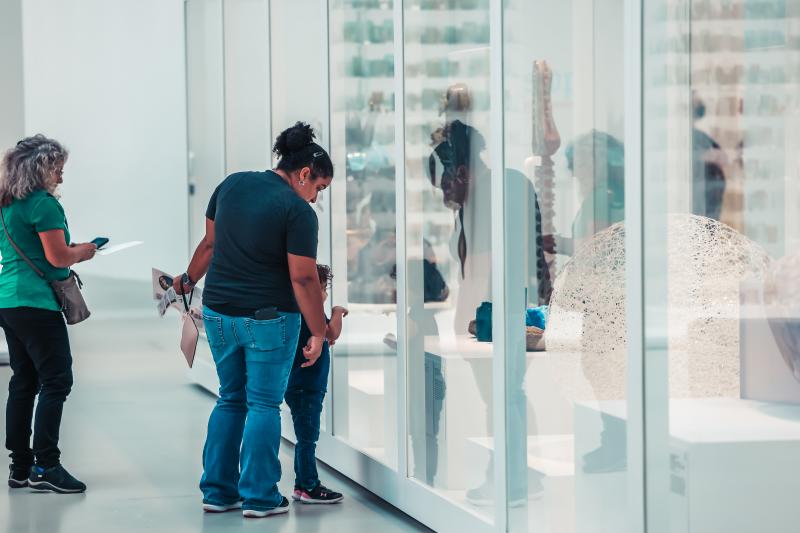
Rockwell Museum
Housed in the beautifully restored 19th-century historic Old City Hall in Corning, The Rockwell Museum is the only Smithsonian Affiliate museum in Upstate New York. Featuring a unique collection of over 5,000 works of fine art representing the American experience through the work of American artists, the diverse collection includes a mix of nineteenth-century paintings, historic bronzes, Native American objects, twentieth-century modernists, illustration art, and contemporary photography. Tip: Purchase a Combination Ticket to access the Rockwell and the Corning Museum of Glass! Take the free shuttle between the two museums for an easy commute!
Something to do no matter the Season
No matter the season, there is always something happening in Corning! Visitors and locals can enjoy the farmers market every Thursday during the summer and fall. Travelers from around the country and region travel in for June’s Pride celebrations. The popular Wine Glass Marathon in the fall is booked up with runners quickly, bringing everyone together to cheer them along. Sparkle is the highlight of the winter holiday season when the Parade of Lights kicks off on the first Saturday after Thanksgiving every year. Then, there are festivals showcasing artisans, musicians, and so much more!
Spot “Little Joe”
The official symbol for Corning is the gaffer, and you can spot “Little Joe,” the gaffer, on the Little Joe Tower. A gaffer, or hot glass worker, is the fitting symbol for Corning as it pays homage to the glass-making history here and has become an icon of the Crystal City.
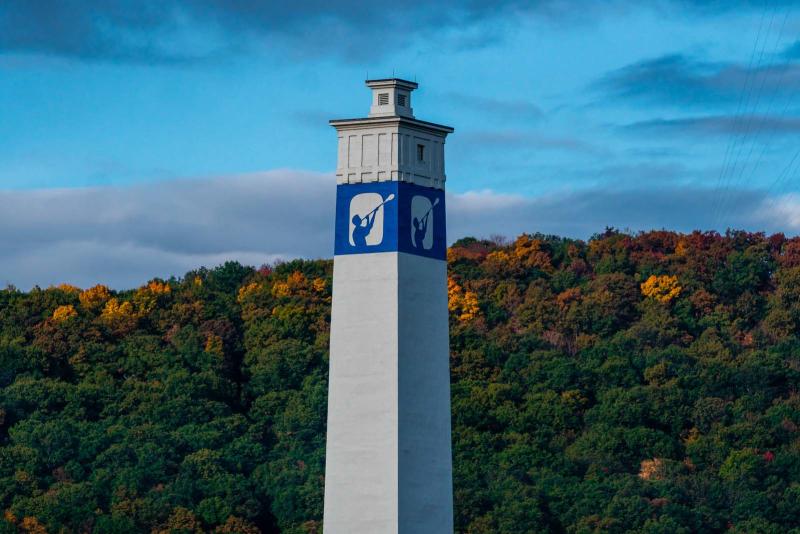
Wine Trails
Corning is just a short drive from Finger Lakes Wine Country’s three incredible wine trails. The southern tips of the Keuka Lake Wine Trail and the Seneca Lake Wine Trail are approximately 30 minutes away, and the Cayuga Lake Wine Trail is less than an hour away.
The Village
In the summer, the Village of Hammondsport is bustling with lake house residents and vacationers who enjoy the village’s small-town feel and welcoming community. There is live music and art shows in the park, as well as boat shows and other festivities to engage locals and visitors alike. Depot Park is a popular hangout spot for beachgoers and boaters and a beautiful place to take in the sunsets.
In the winter, the village is a bit quieter and still, and reminiscent of those beloved holiday movies, with sweet twinkling lights and cute shops and decor.
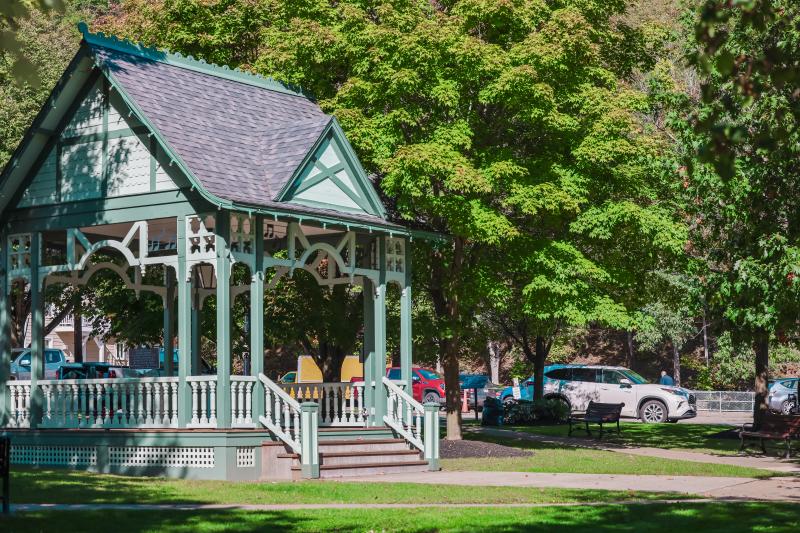
This charming downtown also offers independently- and locally-owned shops and restaurants surrounding the picturesque Pulteney Square and gazebo. Just a few steps away are the shores of Keuka Lake at Depot Park. Stop into local favorites like Crooked Lake Ice Cream for more than ice cream; come for a light breakfast, espresso drinks, or lunch sandwiches and salads. Want something a bit more upscale? Make a reservation at The Park Inn restaurant for seasonal farm-to-table dishes and book a stay in any one of the romantic and cozy rooms upstairs. Other great spots to check out in the village is the Irish Maloney’s Pub, a casual community hangout for drinks and meet-ups, and Vern’s Bakery for fresh-baked goods and some of the biggest croissants you will ever see!
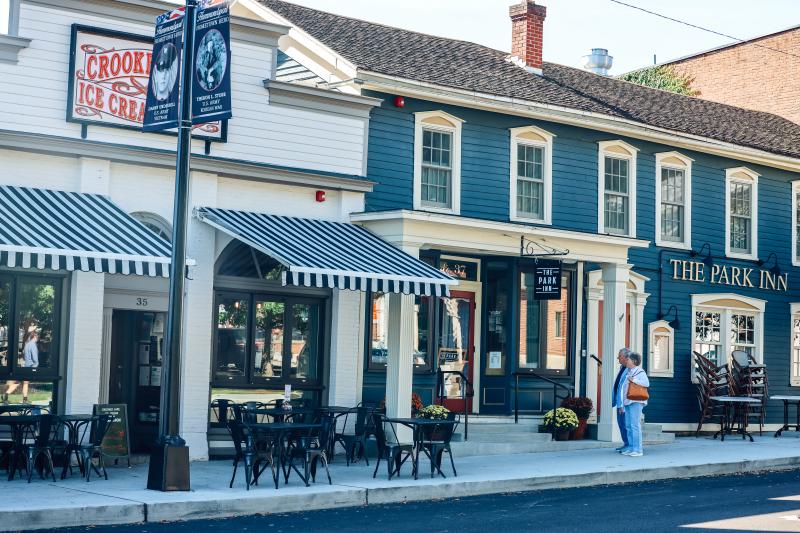
Antiquing
Antique lovers will find a lot of cute shops for treasure hunting. Right in the village are Patina and Opera House Antiques. A short drive away, just on the edge of the village, is Crooked Lake Antiques. Further up off West Lake Road are Stone View Barn and Wild Goose Chase Antiques in Pulteney. Kelley’s Korner Antiques and Collectibles is further up NY-54 on the East side of Keuka Lake.
Museums
Learn the history of the pioneer aviator, “Father of Naval Aviation,” and the “Fastest Man on Earth” while exploring the priceless collection of artifacts at the Glenn H. Curtiss Museum. The museum covers early aviation as well as the inventions of Glenn H. Curtiss, including motorcycles, bicycles, boats, and different aircrafts.
Learn about the Finger Lakes region’s boat-building heritage at the unique Finger Lakes Boating Museum. The museum offers a collection of over 200 antique boats, preserving the vintage art and craftsmanship behind boat building.
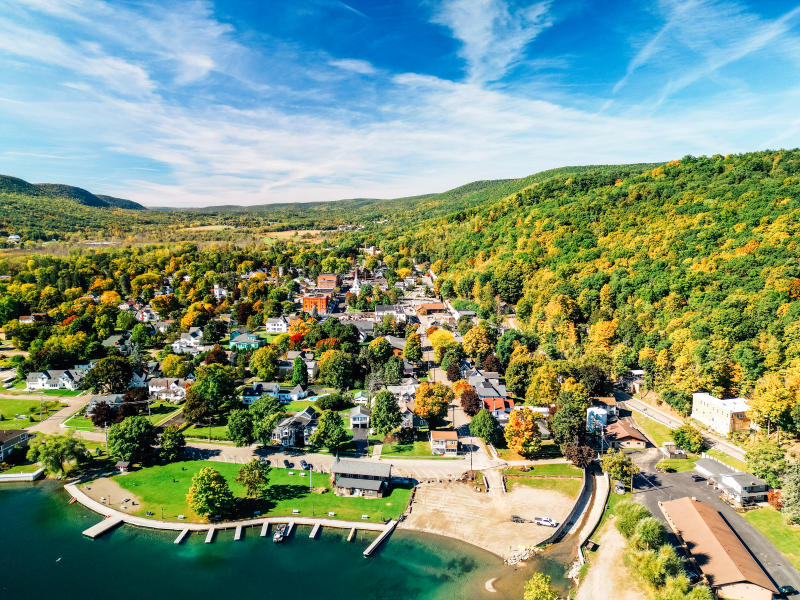
Wineries and Craft Beverage Producers
Hammondsport is home to wineries that pair delicious wine with amazing views of Keuka Lake; Ravines Wine Cellars, Weis Vineyard, Point of The Bluff, Domaine LeSeurre, Keuka Springs, McGregor Vineyards, Hunt Country, and Heron Hill Winery are just a few.
If you want to kick off your wine experience with a bit of history about the evolution of wine in our region, make sure to visit Dr. Konstantin Frank. This winery, located near Hammondsport, was responsible for revolutionizing winemaking in the United States when Dr. Konstantin Frank, a Ukrainian immigrant, successfully developed a method for growing Vinifera, or European wine grapes, in Upstate New York. After 300 years of failed attempts to introduce Vinifera to colder climates, Dr. Frank revolutionized the winemaking landscape the region is known for today. Still, we highly recommend checking out the list on the Keuka Lake Wine Trail website and exploring the Craft Beverage Trail.

Pleasant Valley Wine Company
Visit the oldest winery in the Finger Lakes, located just outside the Village of Hammondsport. It offers historic tours of its property dating back to 1860. Pleasant Valley Wine Company, known for its Great Western Champagne brand, survived the prohibition years by selling sacramental and medicinal wine while sitting on an inventory of 70,000 cases that couldn’t be sold.
Watkins Glen State Park and Other Hikes
One of the most enchanting places for a leisurely hike in New York State is Watkins Glen State Park. Located steps from Watkins Glen’s main street, the two-mile Gorge Trail boasts 19 cascading waterfalls. Visitors can also hike the rim trails overlooking the 200-ft cliffs from above. The state park is closed during the winter months. However, hikers and outdoor lovers can still explore by visiting the year-round Catherine Valley, which allows visitors to experience the scenic beauty and historic charm of the glacially carved valley south of Seneca Lake. This 12-mile trail extends from the Village of Watkins Glen to Horseheads and follows an abandoned railroad and canal towpath corridors, passing through various wildlife habitats. The easy-to-navigate trail is perfect for walking, bicycling, cross-country skiing, and snowshoeing.
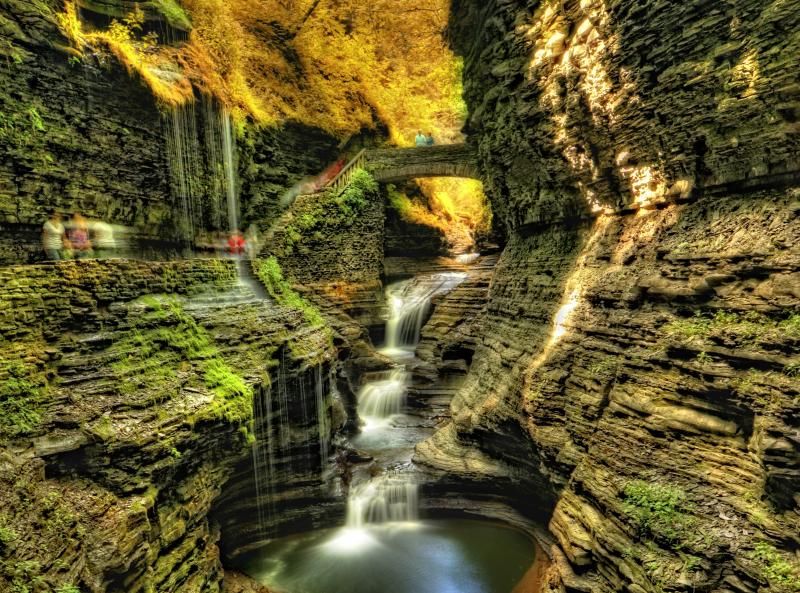
Watkins Glen International & Auto Racing History
Also known as “The Glen,” this road course racetrack hosts NASCAR and IMSA, among other year-round auto racing events. Watkins Glen International is also home to the annual Finger Lakes Wine Festival. Watkins Glen is noted as the Birthplace of American Road Racing. Don’t miss the Grand Prix Festival in September, or visit the International Motor Racing Research Center to learn more about the town’s legacy of auto racing. Watkins Glen International is also one of the best camping experiences for motorsports fans, with “camping weekend” events hosted throughout the year.
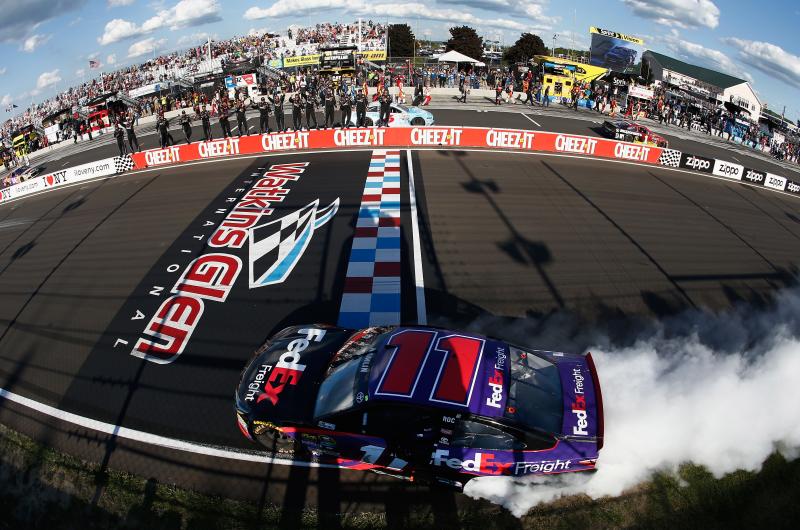
Downtown
You can find the scenic Seneca Lake pier on the south end of Seneca Lake, and from here, you can take a sail on the True Love or go on an excursion with Captain Bill. Explore the different locally owned and independent restaurants, cafes, shops, and bars. What could be better than waking up to the beautiful views of Seneca Lake while staying at the exceptional Watkins Glen Harbor Hotel, named “Best Waterfront Hotel in the Nation” by USA Today. Be sure to stop in at Lucky Hare Bar and Grill for a bite and some great brew (bonus: on warmer days, there’s plenty of seating on the outdoor deck by the lake)!
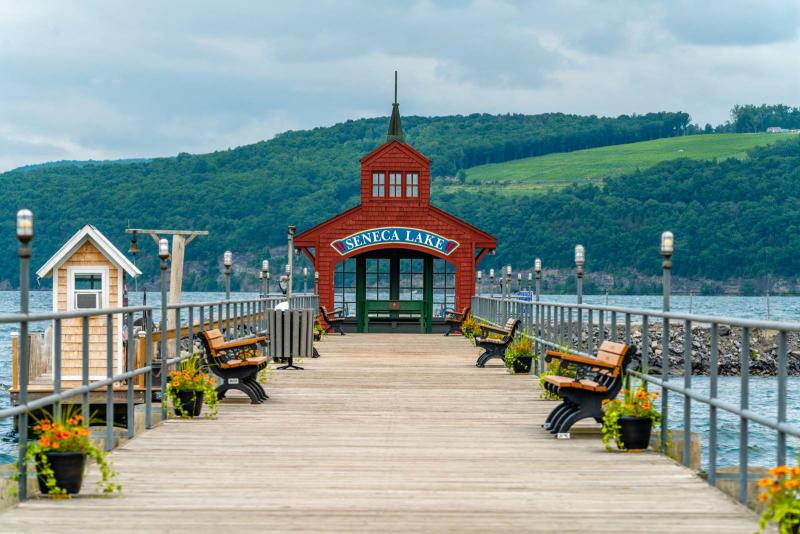
Seneca Lake Wine Trail
Watkins Glen is in a prime location for discovering and tasting your way through the Seneca Lake Wine Trail member wineries. Seneca Lake is the deepest of the lakes, moderating the local climate and making for ideal temperatures for growing grapes. When visiting a Seneca Lake Wine Trail member winery, you are guaranteed to enjoy wine made from grapes grown in the Seneca Lake AVA. Must visits include Lakewood Vineyard, Glenora Wine Cellars (also home to Veraisons Restaurant and a 30-room Inn overlooking the vineyards and lake), Wagner Vineyards (also home to Wagner Valley Brewing and The Ginny Lee Café), Hazlitt 1852 Vineyards, and J.R. Dill Winery, just to name a few!
Hector Falls
Driving along the east side of Seneca Lake, just a mile and a half north of Watkins Glen on Route 414, you will see one of the region’s most beautiful roadside attractions, Hector Falls. Witness this magical, cascading waterfall right from the comfort of your car. You can see the lower falls that feed into the lake from Seneca Lake. Note: this is a roadside waterfall. Please be cautious of fast-moving vehicles when stopping for views and photos.
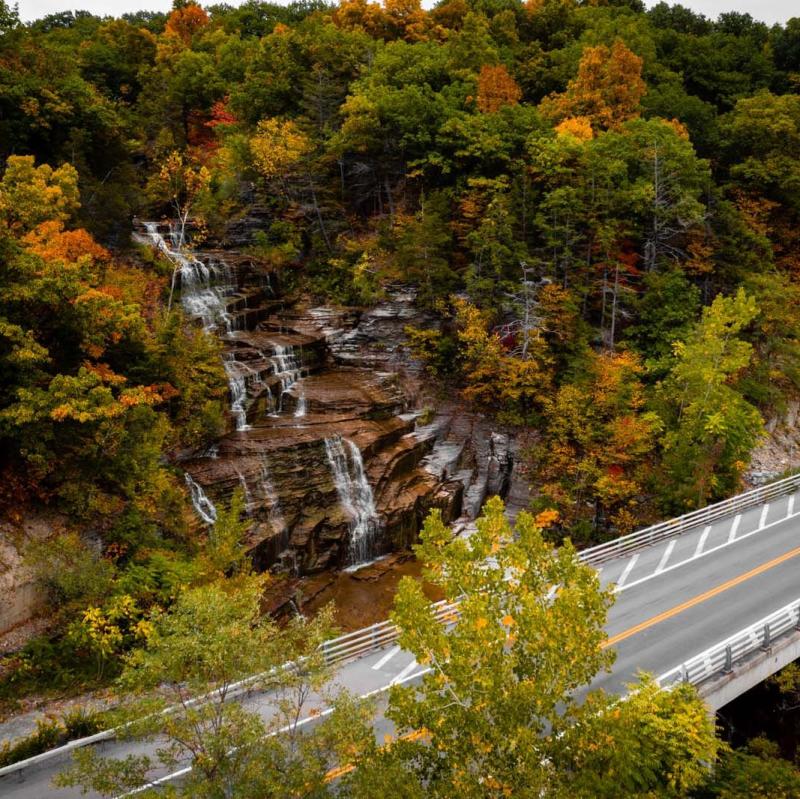
Check out J.R. Dill’s Wine Bar on Franklin St. Here, you can enjoy a leisurely environment, some tasty cocktails, and J.R. Dill wine selections. Graft Wine and Cider Bar serves up some hearty meals that are seasonally and locally inspired. Pair with their great selection of local ciders. Looking for some freshly baked bagels for a morning bite? Check out The Blackberry Inn Kitchen – though arrive early as these delicious bagels go fast! And if you are looking for a delicious cup of coffee, there are some really great options to choose from, starting with Seneca Sunrise Coffee, right in Watkins Glen, or North New York in Montour Falls, and also Overlook Coffee Company in Burdett – as a starter list! Lastly, if you want a nice brunch and breakfast spot, we recommend Elf and The Oak, Jonny’s Kitchen, Stonecat Cafe (seasonal – closed in the winter), and Ryan Williams Vineyard for brunch and lunch…and wine! TIP: Always check out the social media platforms or websites (or call) before visiting, as hours change seasonally.
While Finger Lakes Wine Country is renowned for its award-winning wines there are many breweries, cideries, and distilleries in the region worth bragging about. This is why we created the Finger Lakes Wine Country Breweries, Cideries, and Distilleries Guide.
Craft brewing has exploded so much in the region in the last decade that there are a variety of breweries offering an array of experiences. Some of our breweries even offer lodging. One of them even has a pet-friendly suite. In this guide you will visit town to town to take a sip at the best breweries, cideries, and distilleries in each area.
Penn Yan
The quaint and beautiful Village of Penn Yan, NY was named after its early Pennsylvania and Yankee settlers. This is where you can find independently- and locally- owned cafés, shops, restaurants, and taverns along Main Street’s historic early 19th century buildings.
The Laurentide Inn is the result of transforming a 200-year-old private residence and carriage house barn into five guest suites. In the back of the house, you’ll find their brewery and the pub.
Two other Penn Yan breweries to visit are Abandon Brewing Co. and Climbing Bines Hop Farm & Craft Ale Company. Abandon Brewing Co. is a geothermal-powered craft brewery located in a reused farmhouse overlooking Keuka Lake. You can enjoy tastings in the taproom, a pint in the beer hall, or out on the deck overlooking the grapes, apples, and hops of Abandon Acres. Climbing Bines Craft Ale Company is one of New York State’s first farm breweries. They specialize in small-batch, hand-crafted ales brewed on-site with the freshest estate-grown hops and locally-harvested barley.
If you’d rather sip cider head to WortHog Cidery in Penn Yan. Where they use a special blend of New York Apples to make their ciders and lightly carbonate them for a finishing touch and unique taste.

A few miles away in Keuka Park, NY you’ll find LyonSmith Brewing Co. This brewery has a mission “to make beer that is worth drinking, a company that is worth working for, and a community that is worth living in.”
Dundee
Enjoy a soft pretzel or a meat and cheese board at Keg & Barrel Brewing Co.
while sipping on one of the 20 craft beers, ciders, and sours on-tap. Relax in the newly remodeled tasting room or unwind on the deck for live performances weekly.
If you’re looking for a classic whiskey look no further than Dundee’s O’Begley Distillery. Which produces Traditional Irish Style Whiskey, using a small-batch pot still process.
There is a new brewery that just opened (in the building that used to be Starkey’s Lookout) called Tin Barn Brewing. It’s a brewery based in the Hudson Valley that just opened their first Finger Lakes Wine Country location.
Hammondsport
The picturesque village of Hammondsport, NY is home to Pleasant Valley Wine Company the oldest winery in Finger Lakes Wine Country. They survived the prohibition years by selling sacramental and medicinal wine while sitting on an inventory of 70,000 cases that couldn’t be sold.
At The Brewery of Broken Dreams, their ales are traditionally inspired and uniquely rendered from a combination of resources provided by the naturally abundant farmland, and the desire, knowledge, and skill of local farmers and our brewers.
Finger Lakes Beer Company is a New York State Farm Brewery offering tasting flights, half-pints, pints, and pitchers of a dozen styles of ales all brewed on-site. Be sure to try their Vanilla Porter which won the 2015 Best Craft Beer in New York State at the TAP New York.
The family-run Keuka Brewing Company was the first microbrewery on Keuka Lake. They pride themselves on producing unique small artisan batches of great beer by experimenting in different styles and tastes.
Steuben Brewing Company is a farm brewery that produces New York State-labeled beer. They strive to make great beer that supports local farmers by utilizing ingredients that are grown and produced in New York State.
Krooked Tusker Distillery is a small batch, farm distillery on Keuka Lake that produces handcrafted libations made from locally-sourced materials.
Watkins Glen
From the 19 waterfalls at Watkins Glen State Park to “The Glen”, Grand Prix Festival, and International Motor Racing Research Center there are so many reasons to visit Watkins Glen, NY. Beer is also a big deal in this area. Offering two unique lodging options and more breweries, cideries, and distilleries than any other area.
Watkins Brewery Vacation Rentals is located in a historic building that once housed several businesses including a couple of different breweries. The refurbished building now houses seven vacation rental homes. Pontoon boats, jet skis, kayaks, and bikes are also available for rent on-site for fun Seneca Lake water activities!
Head six minutes north to travel back in time and across the pond to a traditional British Pub. Seneca Lake Brewing Company & The Beerocracy in Rock Stream, NY is the states only dedicated Cask Ale brewery. Adding to the authenticity of the turn of the century British Pub, the Beerocracy Pub offers a cell phone-free bar environment enabling people to truly enjoy the atmosphere and environment. Secure Cubbie’s are available behind the bar to store mobile devices whilst in the bar area and there is a $10 fine if you are caught with your mobile device. All fines are donated to a local charity quarterly.
You can find both Rock Stream Brewery and Rock Stream Distilling on Rock Stream Vineyards which is Seneca Lake’s only licensed Grappa and Grape Brandy distillery. Owner and operator Dr. Mark Karasz Spent three years in Italy learning wine and Grappa production. After returning from Italy, he founded Rock Stream Vineyards and began growing his own grapes, making and bottling wine, brandy, Grappa, and ports.
Head 15-minutes north to Miles Craft Ales at Miles Wine Cellars in Himrod, NY where they are pouring: Calisto Pale Ale, Scottish Lure Ale, Bonfire Brew Ale, and Io Milk Stout.
If you like a historic stay with a theme look no further than the Seneca Lodge Craft Brewing in Watkins Glen. The main lodge was built for the first Grand Prix in The Glen, in 1948. This racing theme can be seen throughout the venue. Suspended from the ceiling in the Tavern Room are Tires from NASCAR champions. Behind the bar, laurel wreaths from the Formula 1 races of the 1970s.
Not only are there cabins, a-frames, and motel rooms on the property there is also a restaurant.
Nearby you’ll find Rooster Fish Brewing Pub, one of New York’s first official farm breweries offering passionately brewed, uniquely world-class craft ale from locally-sourced ingredients. There are at least five craft-style small batch beers and up to four seasonal and special brews. Sample, order a pint, and even take some home with you.
Launched in 1997 on-site at Wagner Vineyards in Lodi, NY, Wagner Valley Brewing Company provides beer-lovers with a variety of award-winning craft-brewed beers. Wagner Valley Brewing Company currently has 9 draft lines with styles rotating often and ranging from light to dark, bitter to sweet. They also produce an all-natural, non-alcoholic, real Draft Root Beer.
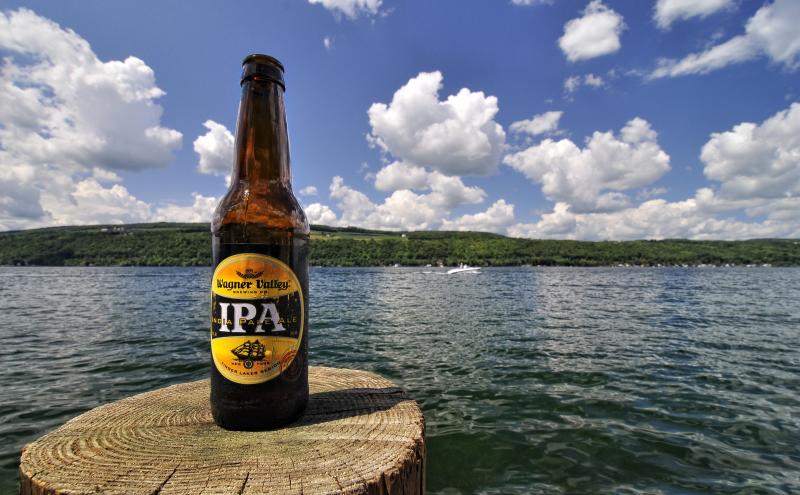
Nearby in Hector, NY is Scale House Brewery where you’ll find quality craft beer and delicious gourmet pizza. Along with Lucky Hare Brewing Company which creates handcrafted beer that reflects their passion for great beer and the Finger Lakes and its community. Choose from two locations, their taproom in Hector and Lucky Hare Brewing Bar & Grill located in the Watkins Glen Village Marina, right next to beautiful Seneca Lake.
The Inn at Grist Iron in Burdett, NY is the only lodging in the region to feature an onsite craft brewery (Grist Iron Brewing Company) with house-brewed beer, BBQ, live music, as well as easy access to local wineries, breweries, restaurants, and hiking/nature trails. Choose from 4 rooms in their traditional-style 1860s Farmhouse or stay in one of 10 spacious suites in The Lodge, which offers rustic, yet modern accommodations including their Dog-Friendly King Room.
You’ll also find Two Goats Brewing and Finger Lakes Distilling in Burdett, NY. Two Goats Brewing is an easy-going gathering place to drink stellar beer, listen to live original music, and enjoy time with friends. It was also built in a renovated 19th-century barn with a sweeping view of Seneca Lake and is powered by solar. Finger Lakes Distilling is the premier New York craft distillery, creating high-quality whiskey, gin, brandy, grappa, and liqueurs. They hand-craft their products using local grains, farm-fresh fruits, and time-honored techniques to produce artisan spirits.
Corning
Corning, New York is a small town with a big reputation. Known for its glass, it is home to 169-year-old Corning Incorporated which has been creating glass cookware since CorningWare (1958), and Pyrex (1915) and is now a center of innovation developing everything from the glass on your cell phone to the glass used in vaccine vials. The town is now known for the Corning Museum of Glass which has been featured on Netflix’s Blown Away, a competition series featuring the art of glassmaking.
Carey’s Brew House is a two-story Brewery Restaurant with a wide range of local and international beers on tap, including in-house brewing of our own recipes, occasional guest brewers, and featured local breweries.
Iron Flamingo Brewery is Corning’s first brewery to bottle beer for distribution. They support local businesses by allowing food to be ordered in and hosting local food vendors regularly. Iron Flamingo Brewery uses local farmers for their hops and malt, helping to sustain the rich agriculture of the region. They are proud to utilize solar power for the brewing process.
Liquid Shoes Brewing is a small batch brewery located in the heart of Corning’s Gaffer District.
Paying homage to the industry that defined Hornell, New York is RailHead Brewing Company. Located where hundreds of rail cars once stood eager for far-off places visit this brewery to be transported to another time.
Cider Creek Hard Cider is made on a family farm nestled in the hills of Canisteo, NY. The company was created in 2013 and turned a family recipe and home brewing passion into a mission to produce high-quality, craft cider. Every batch is handmade with the finest blend of 100% New York State apples.
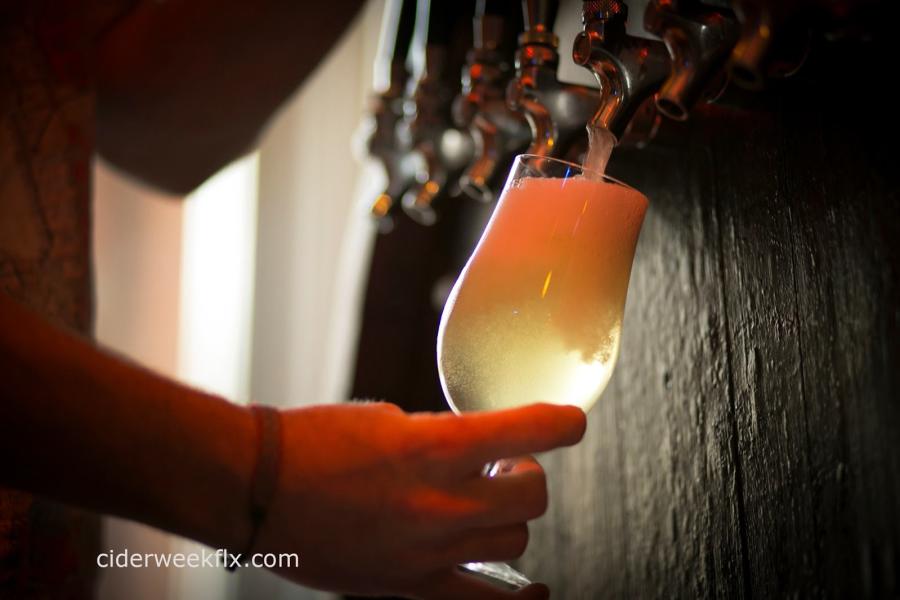
Elmira
Also known as Mark Twain Country, the American author spent his summers in Elmira, New York for more than 20 years. You can even visit the Mark Twain Study and Exhibit on the beautiful campus of Elmira College. Where he penned some of his most famous pieces of literature including The Adventures of Tom Sawyer and The Adventures of Huckleberry Finn, Life on the Mississippi, and more.
Upstate Brewing Company in Elmira, NY is a production micro-brewery that produces fresh, local, and unique beers. Which are currently on tap and in cans at restaurants, bars, and stores in the majority of the counties in New York state.
Eight minutes away in Horseheads, NY is Horseheads Brewing. This family-owned local brewery has the goal to hand-craft the highest quality beer with the finest ingredients, then deliver it at affordable prices. Check out their satellite location located on the marina in Watkins Glen this summer.
Head south to Diversion Brewing Co. a small 3-barrel craft brewery in Chemung, NY with a wide variety of beers available to please any palate.
The second cidery on our list is Eve’s Cidery in Van Etten, NY. Eve’s is an orchard-based cidery producing Traditional Method ciders. With two orchard sites perched on either side of the geological divide between the Southern Finger Lakes and the Northern Appalachian Plateau. The primary impulse behind their cider making is to find an answer to the question: Can you taste a place?
Owego
In Owego, New York you’ll find stately Victorian homes and 19th-century architecture, impressive bookstores, and some of the best antique shops in the region.
10 minutes away in Apalachin, NY is Waterman’s Distillery, an innovative producer of all-natural grain-neutral spirits and whiskeys. This distillery is part of America’s original moonshine trail established by bootleggers traveling east and west during the prohibition era.
Finger Lakes Wine Country offers some of the most beautiful landscapes in New York State. The region is also a haven for waterfall chasing. One might assume that waterfall viewing is best done in the warmer months, but waterfalls truly come to life and are spectacular to see during the winter months. Enjoy sparkling snowy scenes when you visit these five magical waterfalls this winter.
For more ideas of how to spend this season in wine country read our guide to outdoor activities to enjoy in the winter in the Finger Lakes.
Watkins Glen State Park
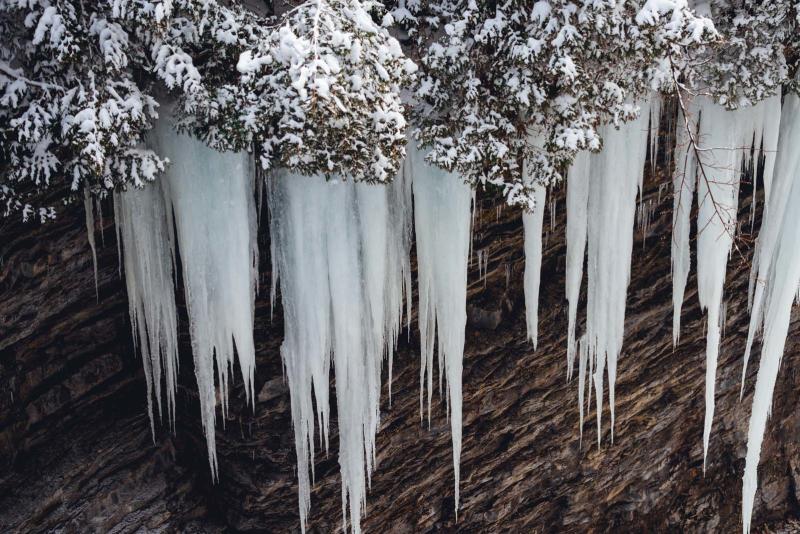
The famous waterfalls of Watkins Glen State Park attract visitors from near and far every year and every season. While the famous Gorge Trail that takes you through 19 cascading waterfalls directly through the gorge is closed in the winter for safety reasons due to icy conditions, the South Rim Trail is open year-round and offers a glimpse of a true winter wonderland from above overlooking the gorge and its waterfalls.
The South Rim Trail passes the scenic stone arched, Sentry Bridge, which gives visitors a peek at the canyon views and Keyhole Falls.
What’s great about visiting this popular natural attraction in the winter is not only the stunning winter scenery, but this is also a less popular time to visit and take in the surrounding beauty with less people.
As with any hike in the winter, use caution as there could be ice.
Seneca Mills Falls
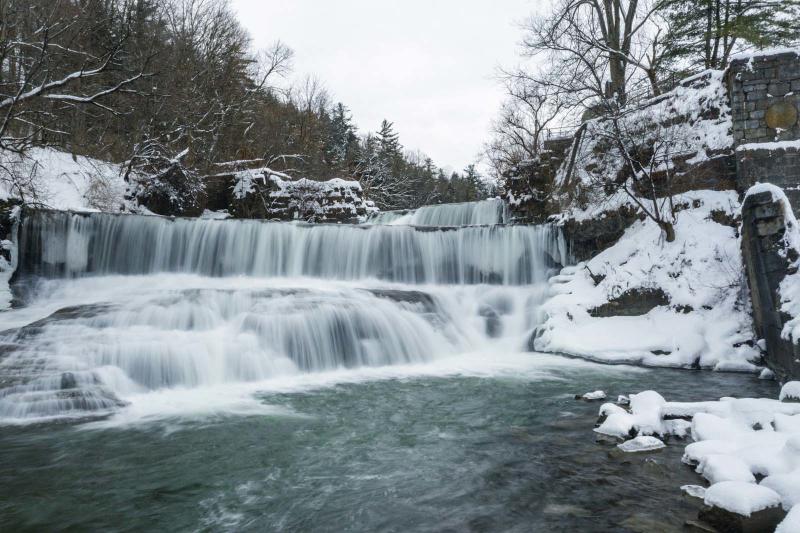
Located just outside of Penn Yan along the 7 mile Keuka Outlet Trail that connects Keuka Lake to Seneca Lake you can find another gorgeous waterfall any season, but especially a sight to see with a layer of snow at Seneca Mills Falls located in the ruins of a former mill.
This 40ft waterfall can be accessed by foot along the Keuka Outlet Trail or by enjoying other winter activities like snowshoeing, horseback riding, and snowmobiling.
If you’re looking for the quickest way to visit Seneca Mills Falls, you will want to find the small parking area on Outlet Road around three miles outside of the town of Penn Yan. From here you can enjoy the easy walk along the trail for about .3 miles before approaching the scenic waterfall.
Aunt Sarah Falls

Another roadside waterfall in wine country that is especially beautiful in winter is Aunt Sarah Falls, located on State Route 414 just north of the village of Montour Falls.
This is one of the waterfalls in the region that is very dependent on waterflow. During a dry summer you won’t be able to see Aunt Sarah Falls, but luckily in the colder days of winter the flow freezes and makes for a really beautiful frozen waterfall and giant icicle scene.
There is a parking area right next to the falls making it a very easy and quick stop, even on the coldest of days!
She-Qua-Ga Falls
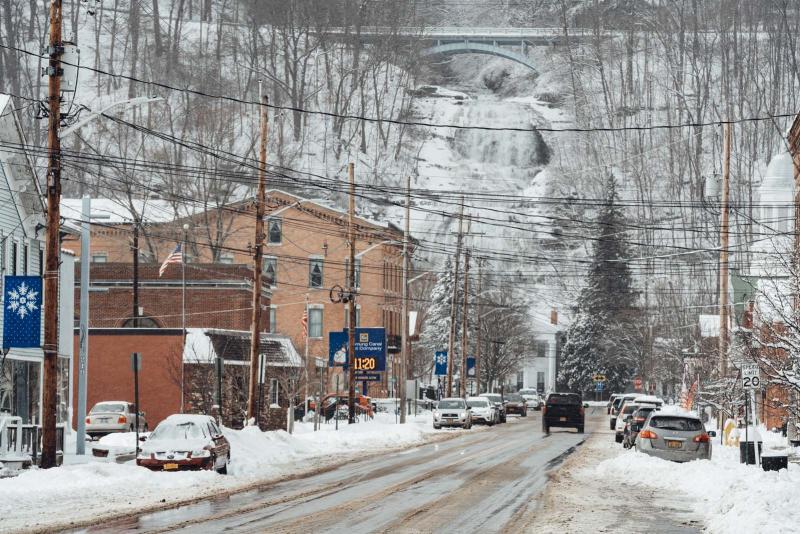
Towering above the village of Montour Falls at 156 feet, She-Qua-Ga Falls is another scenic gem of the region and absolutely gorgeous in the winter. Situated between residential homes and the village of Montour Falls you can witness this stunning waterfall from the viewing platform, driving through the village, and from Main Street.
The name of She-Qua-Ga Falls means ‘tumbling waters’ in the Seneca language as this site was formerly a Seneca Tribe village.
A surprising fact about She-Qua-Ga Falls and Montour Falls is that you can find a sketch of it on display in The Louvre in Paris completed by King Louis Philippe d’ Orleans of France.
During a really dry season, it’s hard to see this waterfall, but in the winter you not only get water flow but all the frozen beauty around it.
Honerable Mention
Hector Falls
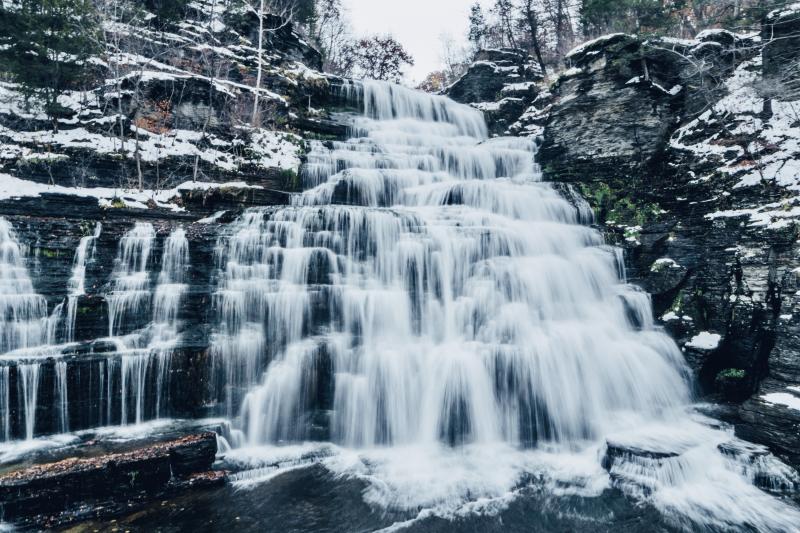
Catch a glimpse of one of the most well-known waterfalls in the region while driving along State Route 414. The cascading Hector Falls is truly stunning every season of the year – and it can be viewed right from your car!
In the winter, you are rewarded with a view of the cascading water dusted with snow and ice. From this spot, you’re witnessing the upper falls, what you won’t be able to see from this vantage point are the series of waterfalls below the bridge you’re driving on flowing into Seneca Lake.
Please do not exit your car to view this waterfall.
Guests will enjoy a complimentary hot buffet breakfast, high speed Wi-Fi throughout the hotel, an elegantly designed lobby and guest rooms complete with local flare, 24-hour state of the art fitness center, 24-hour business center, indoor heated pool, meeting/banquet facilities, outdoor seating with gas fire pits and free parking. We offer a mini-fridge, microwave, coffeemaker, 40-inch LED TV’s, and Sealy® pillow top mattress in all of our guestrooms. Guests can also take advantage of our ADA compliant amenities and services, including handicap parking, wheelchair access to the hotel and wheelchair accessible rooms, vision and hearing impaired alarms, and ADA compliant rooms with roll-in showers, grab bars and lowered storage.
Business travelers will appreciate the newly constructed Hammondsport Hotel, Best Western Plus® and are always a welcome delight. In addition to all of the amenities and comforts we have to offer, guests will also enjoy a short commute while visiting The Glenn Curtiss Museum, The Finger Lakes Boating Museum, Watkins Glen International Speedway, world class local wineries/breweries/distilleries, and exceptional local restaurants and businesses in the Hammondsport town center.
Book your upcoming stay at The Best Western Plus, Hammondsport Hotel and find out why we are the best hotel in the “coolest small town in America”!
